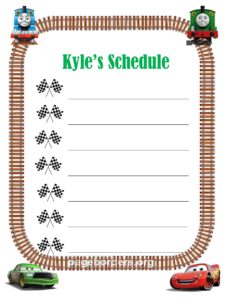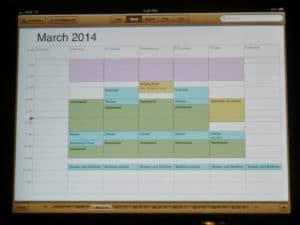For those who have autism, the holidays can be a very overwhelming time of year. Excitement shifts into high gear. They must deal with lights and decorations, busy stores, extra traveling, family gatherings, and more people everywhere they go. Not to mention, if they are school-age, the routines they thrive on are interrupted by holiday parties in the classrooms and then a long break.
The new year may bring adjustments to our loved ones’ schedules, and so it is a great time to revisit how we use visual schedules to support them.
 Do we start (for the first time) implementing a schedule? Schedules can provide predictability and structure that individuals with Autism Spectrum Disorder can use to better navigate their day. Schedules can also lessen individuals’ anxiety. Schedules should be customized for each individual.
Do we start (for the first time) implementing a schedule? Schedules can provide predictability and structure that individuals with Autism Spectrum Disorder can use to better navigate their day. Schedules can also lessen individuals’ anxiety. Schedules should be customized for each individual.
Do we make format changes to an existing schedule? Perhaps the existing schedule needs to look more age appropriate, yet remain effective to meet the needs of their personal level of function.
Do we change from pictures to written words? When my son Logan started to read, I effectively changed his picture schedule into a schedule of written words.
Do we move the schedule to a dry-erase board and into a central location in the house? A schedule should be in a location that can be accessed easily if your loved one needs to look at it periodically over the course of the day.
 Do we move the schedule to an iPad or iPhone? Sometimes electronics can be a great motivator, as long as the individual uses this method appropriately so that it remains effective.
Do we move the schedule to an iPad or iPhone? Sometimes electronics can be a great motivator, as long as the individual uses this method appropriately so that it remains effective.
Do we keep the format the same, because it has been working well? If it’s working well, it may be best to leave it as is.
Do we add chores for our loved one? I created a separate schedule for Logan that outlined his chores around the house. I also included this in his daily schedule.
Do we alter the time frames for preferred activities and make them shorter? Excessive interest in a particular topic or item can become a concern. Scheduling start and end times allows the person creating the schedule to adjust that time frame as needed.
Do we add more sensory breaks into the schedule? Giving an individual a rest period or a break in their day can certainly make all the difference.
Do we add a checklist, so that the individual can exercise some control over his or her day? Checklists have worked very effectively for some individuals with ASD, as it gives them some control and they can be part of the process by completing the activity with a personal check off box. This can be very good for one’s self-esteem as well.
Is our child able to create and follow his or her own schedule? This would be an ideal long-term goal, if this is something that can be accomplished. Some will benefit more with the continued supports. All people with autism have their own unique ways and needs.
A new year is not just a time for us adults to change the batteries in our smoke detectors, but it’s also a great time in helping our children with their need for structure and predictability.
Happy New Year, and I hope it is filled with good health, happiness, predictability, and structure!
Resources
Why Schedules Matter, article on pages 6-7 in the summer 2015 Spectrum
Juliette Heim, an ASNC Autism Resource Specialist in Asheville and mom to a son with autism, can be reached at jheim@autismsociety-nc.org.
Tags: ASNC, autism, autism anxiety, autism asperger parenting tips, autism behavior, autism education, autism resources, autism society north carolina, autism society of NC, Autism Society of North Carolina, Autism spectrum, Autism Spectrum Disorder, Autism Spectrum Disorders, autism support, autism visual schedule, autism visual support Go back

